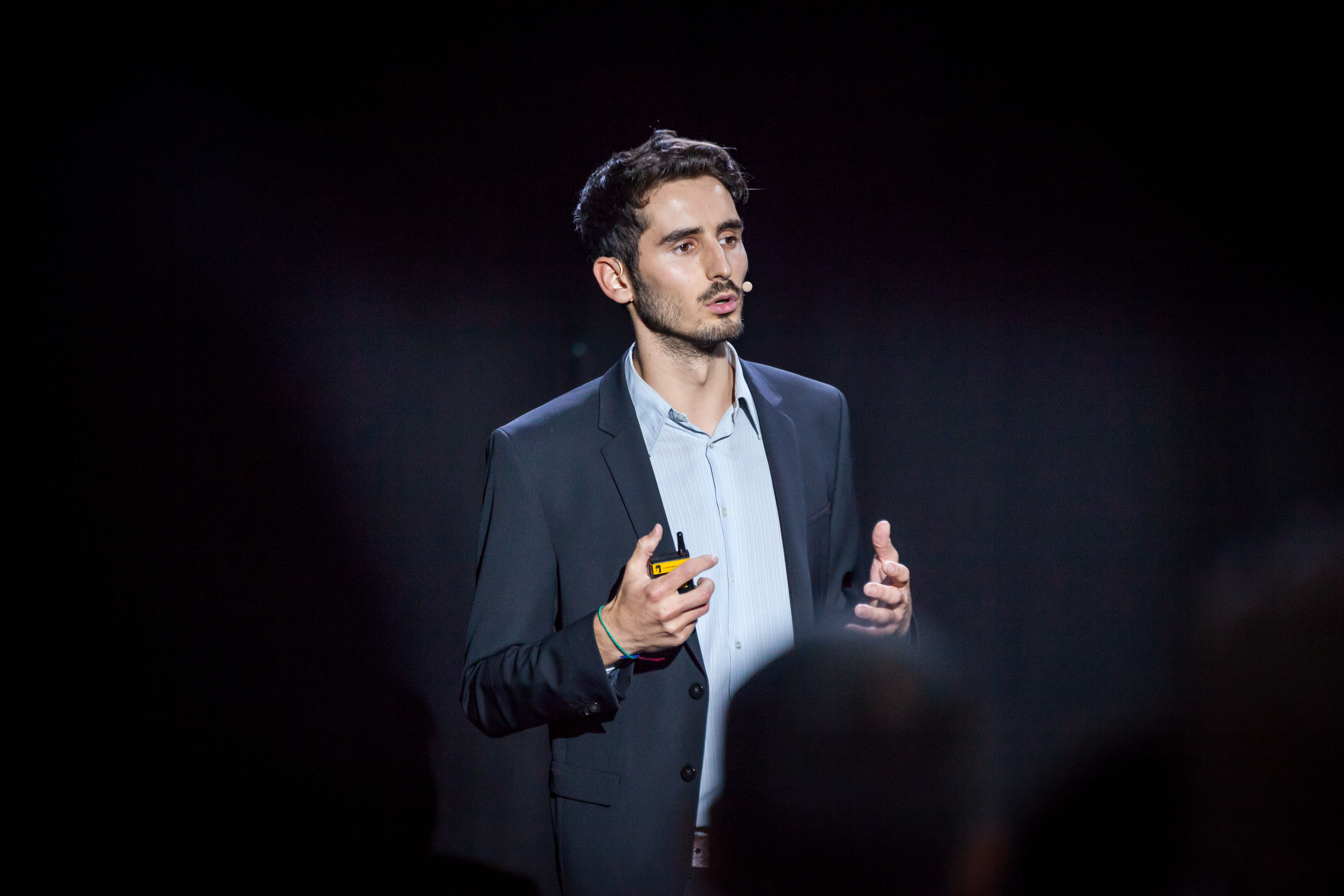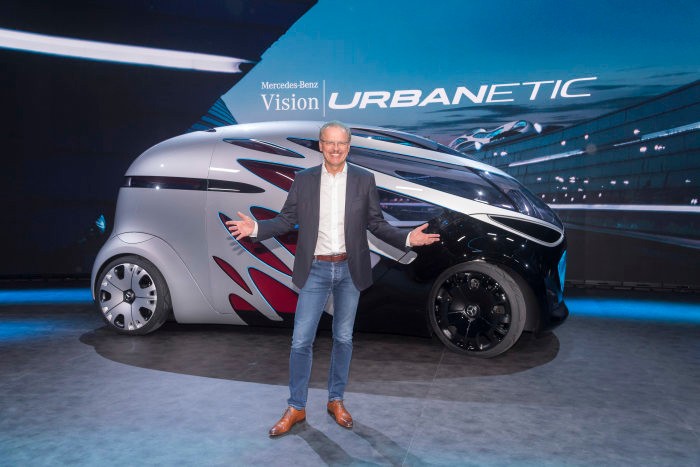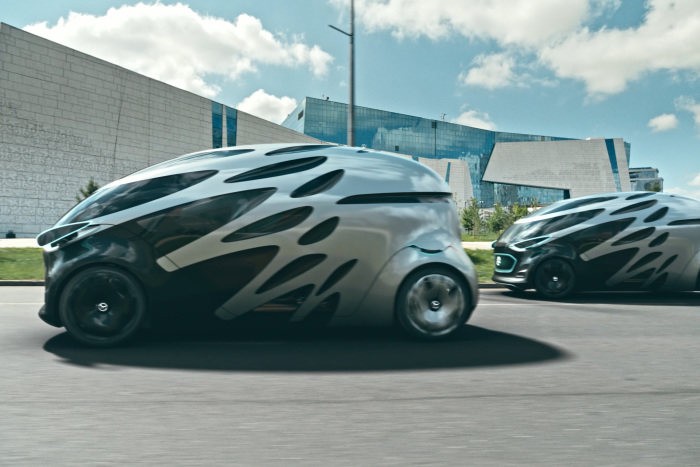FRANKFURT, Sept 14 (Reuters) – ChargePoint, operator of one of the world’s largest charging station networks for electric vehicles (EV), is targeting a near fifty-fold increase in its global network of loading spots by the middle of next decade, it said on Friday. The group, in which German companies BMW , Daimler and Siemens hold… Continue reading ChargePoint to grow global EV charging network to 2.5 mln
Tag: Daimler
Baidu sets its sights on taking A.I. and self-driving cars outside China
Baidu sets its sights on taking A.I. and self-driving cars outside China
Online search provider Baidu — referred to as the Google of China — has been expanding aggressively into cutting edge technology such as artificial intelligence and autonomous vehicles.
The Chines tech titan is one of the largest internet companies in the world with a strong user base, thanks in no small part to China's massive population of 1.4 billion people.
About 70 percent of China's internet searches go through Baidu. The Chinese-language search platform is one of the most visited websites in the world, with its traffic surpassed only by Google, YouTube and Facebook, according to Alexa Internet, which measures web data and analytics.
Most of Baidu's revenue comes from online advertising. While its primary business is its search engine, it also offers maps, images, videos and news platforms to users. It's also a majority stakeholder in iQiyi, widely referred to as the Netflix of China.
But like other Chinese internet firms, Baidu is subject to Beijing's strict online censorship laws. The government has fined companies, including Baidu, for failing to properly censor content on its platforms.
Baidu is also investing heavily into its autonomous vehicle projects and has formed partnerships with the likes of Microsoft and Intel, and carmakers BMW, Ford and Daimler.
Leading the charge in China's push for driverless technology, Baidu has already developed and produced more than 100 self-driving buses. The autonomous vehicles will soon be deployed to the streets of Beijing and Shenzhen, and are due to enter Japan's self-driving market in early 2019.
The company has set its sights on markets outside China. It's next move would be to take its AI and self-driving technology to foreign markets, bringing it one step closer to becoming a global tech titan.
more from Tech
To view this site, you need to have JavaScript enabled in your browser, and either the Flash Plugin or an HTML5-Video enabled browser. Download the latest Flash player and try again.
German authorities uncover emissions-cheating collusion among diesel automakers
2014 Mercedes-Benz E250 BlueTec 4Matic
New documents revealed in a German investigation into diesel emissions cheating show that German automakers, including Volkswagen, BMW, and Mercedes-Benz may have colluded to limit the amount of emissions-cleaning AdBlue diesel exhaust fluid the cars used.
The news was reported by the German newspaper Handelsblatt on Tuesday.
The AdBlue urea solution was contained in tanks too small to last the specified distance between refills, internal company documents reveal. In one 2008 email, an Audi engineer wrote that if customers had to refill their tanks every two months, “it would be a disaster for the entire clean diesel strategy in North America…. This assessment is shared also by VW, BMW, and Daimler.” (Daimler is the parent company that produces Mercedes-Benz cars.)
DON'T MISS: Volkswagen fires six managers over diesel emissions cheating
The documents were revealed as part of a criminal investigation in Germany of 39 Volkswagen executives for fraud and deceptive advertising.
An Audi presentation uncovered last year referred to a “commitment of the German automotive manufacturers at board level” to using smaller urea tanks and making them last longer.
All three automakers, BMW, and Mercedes-Benz, along with Volkswagen and its luxury division Audi, submitted documents to German regulators showing that the cars would use 0.26 gallons (1 liter), of urea fluid in 1,000 miles of driving, when it fact it would take 0.78 gallons (3 liters) of the fluid to neutralize emissions for that distance.
CHECK OUT: Mercedes-Benz gets its own diesel emission cheating questions now
The documents show email exchanges among the companies discussing a German investigation into “defeat device software” used to minimize urea consumption and flout emissions laws when the cars were driven on the road, and still meet the requirements when the cars were tested.
All three automakers, plus Fiat Chrysler Automobiles, used emissions hardware and software from German supplier Bosch, which has also been sued for its role in the scandal.
READ THIS: Those fuel-efficient diesels? Actually worse on lifetime CO2, study says
The emissions cheating led to a historic settlement with Volkswagen that has cost the automaker an estimated $30 billion, including buying back most of the diesel models it sold in the U.S.
Bosch has settled lawsuits against it in relation to the scandal.
Class-action lawsuits are outstanding against BMW, Mercedes-Benz, and FCA.
Paragraph attracts: BMW shortens lagging behind Mercedes
All articles and backgrounds 09/13/2018 Sales move to BMW Shortened backlog to Mercedes BMW BMW 3 Series: shortened distance to Mercedes-Benz The carmaker BMW Show stock market chart gained momentum in sales in August, shortening the gap to rival Mercedes-Benz. In August, the number of BMW cars sold increased by 3.2 percent to 151 633,… Continue reading Paragraph attracts: BMW shortens lagging behind Mercedes
The surprise egg from Mercedes-Benz
‘,e.appendChild(e.resizeSensor),e.resizeSensor.offsetParent!==e&&(e.style.position=”relative”);var r,s,d,a,l=e.resizeSensor.childNodes[0],c=l.childNodes[0],u=e.resizeSensor.childNodes[1],h=e.offsetWidth,f=e.offsetHeight,m=function(){c.style.width=”100000px”,c.style.height=”100000px”,l.scrollLeft=1e5,l.scrollTop=1e5,u.scrollLeft=1e5,u.scrollTop=1e5};m();var p=function(){s=0,r&&(h=d,f=a,e.resizedAttached&&e.resizedAttached.call())},v=function(){d=e.offsetWidth,a=e.offsetHeight,(r=d!=h||a!=f)&&!s&&(s=t(p)),m()},y=function(e,t,n){e.attachEvent?e.attachEvent(“on”+t,n):e.addEventListener(t,n)};y(l,”scroll”,v),y(u,”scroll”,v)}}(e,o)}),this.detach=function(e){n.detach(i,e)}};return n.detach=function(t,n){e(t,function(e){e&&(e.resizedAttached&&”function”==typeof n&&(e.resizedAttached.remove(n),e.resizedAttached.length())||e.resizeSensor&&(e.contains(e.resizeSensor)&&e.removeChild(e.resizeSensor),delete e.resizeSensor,delete e.resizedAttached))})},n}),function(e,t){“function”==typeof define&&define.amd?define([“./ResizeSensor.js”],t):”object”==typeof exports?module.exports=t(require(“./ResizeSensor.js”)):(e.ElementQueries=t(e.ResizeSensor),e.ElementQueries.listen())}(“undefined”!=typeof window?window:this,function(e){var t=function(){function n(e){e||(e=document.documentElement);var t=window.getComputedStyle(e,null).fontSize;return parseFloat(t)||16}function i(e,t){var i=t.split(/d/),o=i[i.length-1];switch(t=parseFloat(t),o){case”px”:return t;case”em”:return t*n(e);case”rem”:return t*n();case”vw”:return t*document.documentElement.clientWidth/100;case”vh”:return t*document.documentElement.clientHeight/100;case”vmin”:case”vmax”:var r=document.documentElement.clientWidth/100,s=document.documentElement.clientHeight/100;return t*(0,Math[“vmin”===o?”min”:”max”])(r,s);default:return t}}function o(t,n){t.elementQueriesSetupInformation?t.elementQueriesSetupInformation.addOption(n):(t.elementQueriesSetupInformation=new function(e){this.element=e,this.options={};var t,n,o,r,s,d,a,l=0,c=0;this.addOption=function(e){var t=[e.mode,e.property,e.value].join(“,”);this.options[t]=e};var u=[“min-width”,”min-height”,”max-width”,”max-height”];this.call=function(){for(t in l=this.element.offsetWidth,c=this.element.offsetHeight,s={},this.options)this.options.hasOwnProperty(t)&&(n=this.options[t],o=i(this.element,n.value),r=”width”==n.property?l:c,a=n.mode+”-“+n.property,d=””,”min”!=n.mode||o>r||(d+=n.value),”max”!=n.mode||r>o||(d+=n.value),s[a]||(s[a]=””),d&&-1===(” “+s[a]+” “).indexOf(” “+d+” “)&&(s[a]+=” “+d));for(var e in u)u.hasOwnProperty(e)&&(s[u[e]]?this.element.setAttribute(u[e],s[u[e]].substr(1)):this.element.removeAttribute(u[e]))}}(t),t.elementQueriesSetupInformation.addOption(n),t.elementQueriesSensor=new e(t,function(){t.elementQueriesSetupInformation.call()})),t.elementQueriesSetupInformation.call(),l&&c.indexOf(t)o[e].minWidth&&(n=e);if(n||(n=s),d!=n)if(a[n])i[d].style.display=”none”,i[n].style.display=”block”,d=n;else{var l=new Image;l.onload=function(){i[n].src=r[n],i[d].style.display=”none”,i[n].style.display=”block”,a[n]=!0,d=n},l.src=r[n]}else i[n].src=r[n]}var i=[],o=[],r=[],s=0,d=-1,a=[];for(var u in t.children)if(t.children.hasOwnProperty(u)&&t.children[u].tagName&&”img”===t.children[u].tagName.toLowerCase()){i.push(t.children[u]);var h=t.children[u].getAttribute(“min-width”)||t.children[u].getAttribute(“data-min-width”),f=t.children[u].getAttribute(“data-src”)||t.children[u].getAttribute(“url”);r.push(f);var m={minWidth:h};o.push(m),h?t.children[u].style.display=”none”:(s=i.length-1,t.children[u].style.display=”block”)}d=s,t.resizeSensor=new e(t,n),n(),l&&c.push(t)}function d(e){var t,n,i,o,r,s;for(e=e.replace(/’/g,’”‘);null!==(t=h.exec(e));)for(n=t[1]+t[3],attrs=t[2];null!==(attrMatch=f.exec(attrs));)i=n,o=attrMatch[1],r=attrMatch[2],s=attrMatch[3],void 0===u[o]&&(u[o]={}),void 0===u[o][r]&&(u[o][r]={}),void 0===u[o][r][s]?u[o][r][s]=i:u[o][r][s]+=”,”+i}function… Continue reading The surprise egg from Mercedes-Benz
Daimler wants to stir up the used-car market with VW
‘,e.appendChild(e.resizeSensor),e.resizeSensor.offsetParent!==e&&(e.style.position=”relative”);var r,s,d,a,l=e.resizeSensor.childNodes[0],c=l.childNodes[0],u=e.resizeSensor.childNodes[1],h=e.offsetWidth,f=e.offsetHeight,m=function(){c.style.width=”100000px”,c.style.height=”100000px”,l.scrollLeft=1e5,l.scrollTop=1e5,u.scrollLeft=1e5,u.scrollTop=1e5};m();var p=function(){s=0,r&&(h=d,f=a,e.resizedAttached&&e.resizedAttached.call())},v=function(){d=e.offsetWidth,a=e.offsetHeight,(r=d!=h||a!=f)&&!s&&(s=t(p)),m()},y=function(e,t,n){e.attachEvent?e.attachEvent(“on”+t,n):e.addEventListener(t,n)};y(l,”scroll”,v),y(u,”scroll”,v)}}(e,o)}),this.detach=function(e){n.detach(i,e)}};return n.detach=function(t,n){e(t,function(e){e&&(e.resizedAttached&&”function”==typeof n&&(e.resizedAttached.remove(n),e.resizedAttached.length())||e.resizeSensor&&(e.contains(e.resizeSensor)&&e.removeChild(e.resizeSensor),delete e.resizeSensor,delete e.resizedAttached))})},n}),function(e,t){“function”==typeof define&&define.amd?define([“./ResizeSensor.js”],t):”object”==typeof exports?module.exports=t(require(“./ResizeSensor.js”)):(e.ElementQueries=t(e.ResizeSensor),e.ElementQueries.listen())}(“undefined”!=typeof window?window:this,function(e){var t=function(){function n(e){e||(e=document.documentElement);var t=window.getComputedStyle(e,null).fontSize;return parseFloat(t)||16}function i(e,t){var i=t.split(/d/),o=i[i.length-1];switch(t=parseFloat(t),o){case”px”:return t;case”em”:return t*n(e);case”rem”:return t*n();case”vw”:return t*document.documentElement.clientWidth/100;case”vh”:return t*document.documentElement.clientHeight/100;case”vmin”:case”vmax”:var r=document.documentElement.clientWidth/100,s=document.documentElement.clientHeight/100;return t*(0,Math[“vmin”===o?”min”:”max”])(r,s);default:return t}}function o(t,n){t.elementQueriesSetupInformation?t.elementQueriesSetupInformation.addOption(n):(t.elementQueriesSetupInformation=new function(e){this.element=e,this.options={};var t,n,o,r,s,d,a,l=0,c=0;this.addOption=function(e){var t=[e.mode,e.property,e.value].join(“,”);this.options[t]=e};var u=[“min-width”,”min-height”,”max-width”,”max-height”];this.call=function(){for(t in l=this.element.offsetWidth,c=this.element.offsetHeight,s={},this.options)this.options.hasOwnProperty(t)&&(n=this.options[t],o=i(this.element,n.value),r=”width”==n.property?l:c,a=n.mode+”-“+n.property,d=””,”min”!=n.mode||o>r||(d+=n.value),”max”!=n.mode||r>o||(d+=n.value),s[a]||(s[a]=””),d&&-1===(” “+s[a]+” “).indexOf(” “+d+” “)&&(s[a]+=” “+d));for(var e in u)u.hasOwnProperty(e)&&(s[u[e]]?this.element.setAttribute(u[e],s[u[e]].substr(1)):this.element.removeAttribute(u[e]))}}(t),t.elementQueriesSetupInformation.addOption(n),t.elementQueriesSensor=new e(t,function(){t.elementQueriesSetupInformation.call()})),t.elementQueriesSetupInformation.call(),l&&c.indexOf(t)o[e].minWidth&&(n=e);if(n||(n=s),d!=n)if(a[n])i[d].style.display=”none”,i[n].style.display=”block”,d=n;else{var l=new Image;l.onload=function(){i[n].src=r[n],i[d].style.display=”none”,i[n].style.display=”block”,a[n]=!0,d=n},l.src=r[n]}else i[n].src=r[n]}var i=[],o=[],r=[],s=0,d=-1,a=[];for(var u in t.children)if(t.children.hasOwnProperty(u)&&t.children[u].tagName&&”img”===t.children[u].tagName.toLowerCase()){i.push(t.children[u]);var h=t.children[u].getAttribute(“min-width”)||t.children[u].getAttribute(“data-min-width”),f=t.children[u].getAttribute(“data-src”)||t.children[u].getAttribute(“url”);r.push(f);var m={minWidth:h};o.push(m),h?t.children[u].style.display=”none”:(s=i.length-1,t.children[u].style.display=”block”)}d=s,t.resizeSensor=new e(t,n),n(),l&&c.push(t)}function d(e){var t,n,i,o,r,s;for(e=e.replace(/’/g,’”‘);null!==(t=h.exec(e));)for(n=t[1]+t[3],attrs=t[2];null!==(attrMatch=f.exec(attrs));)i=n,o=attrMatch[1],r=attrMatch[2],s=attrMatch[3],void 0===u[o]&&(u[o]={}),void 0===u[o][r]&&(u[o][r]={}),void 0===u[o][r][s]?u[o][r][s]=i:u[o][r][s]+=”,”+i}function… Continue reading Daimler wants to stir up the used-car market with VW
Discover Sono Motors’ vision of the electric car at Disrupt Berlin
New car makers have been popping up left and right. But instead of creating yet another Tesla-like company, German company Sono Motors is working on something completely new — a solar-powered car. That’s why I’m excited to announce that the company’s co-founder and CEO Laurin Hahn will join us at TechCrunch Disrupt Berlin. Sono Motors… Continue reading Discover Sono Motors’ vision of the electric car at Disrupt Berlin
Chevy recalls some Bolt EVs, Volts over supplier brake issues
2018 Chevrolet Bolt EV
Chevrolet this week recalled three to four months worth of production Bolt EVs and Volt plug-in hybrids over a potential brake issue that could increase stopping distances of the small vehicles.
The recall affects 2018-2019 Chevrolet Bolt EV and 2018-2019 Volt models sold in the U.S. and Canada.
General Motors' filing with federal regulators doesn't specify the number of cars or say when owners should begin receiving mailed notices for the proposed fixes, and Chevrolet was unable to confirm those details immediately. Affected Bolt EVs were produced between March 27, 2018 and July 17, 2018 and affected Volts were produced between March 27, 2018 and June 20, 2018.
DON'T MISS: 2018 Chevy Bolts recalled to update battery software, prevent shutdowns
According to GM, rear brake pistons that were improperly chromed and tempered could leak and trap hydrogen gas in the brake lines and could lead to soft or spongy brake pedals.
The faulty brake systems could stretch braking distances of the affected models. Officials said drivers should notice the spongy brake pedal within 15 days of the vehicle's assembly. Dealers were instructed to bleed the brake system to relieve any trapped hydrogen gas.In its filing, GM said it was not aware of any crashes or injuries related to the defect.
CHECK OUT: 2019 Chevy Volt gets higher prices with more equipment
The defective brake pedals are part of a larger recall affecting Mercedes-Benz vehicles and could be related to a similar recall by Fiat Chrysler Automobiles. German supplier ZF said it was aware of the issue, but in its filing GM said the supplier did not notify it that the issue could affect Chevy, Buick, GMC, and Cadillac vehicles.
GM issued the recall this week for more than 230,000 vehicles that also included Chevrolet Cruze, Equinox, Impala, and Malibu sedans and crossovers; GMC Terrain crossovers; Buick LaCrosse, and Cadillac XTS sedans.
Vision URBANETIC: On demand, efficient and sustainable
10.
September 2018
Copenhagen
Completely new mobility concept for on-demand, efficient, comfortable and sustainable mobility Autonomous driving platform that can be fitted as required with a cargo module for goods transportation or with a people-mover module Battery-electric drive for zero local emissions and virtually noiseless mobility Mobility concepts embedded within an intelligent, self-learning IT infrastructure for the continual analysis of transportation needs Supply and demand captured in real time and vehicle resources used to optimum effect Maximum economy, efficiency and flexibility for cities, mobility providers and users Copenhagen – Today Mercedes-Benz Vans presents its Vision URBANETIC, a revolutionary mobility concept that goes way beyond existing ideas on autonomous vehicles. Vision URBANETIC eliminates the separation between people moving and goods transport. It enables on-demand, sustainable and efficient movement of people and goods – and applies an innovative approach to fulfil the needs of cities, businesses from diverse sectors as well as city dwellers and travellers. The concept reduces traffic flows, relieves inner-city infrastructures and contributes to an improved quality of urban life.
As part of a holistic system solution, Vision URBANETIC addresses future urban challenges and offers innovative solutions. The visionary concept is based on a self-driving, electrically powered chassis that can take different switchable bodies for people moving or goods transport. As a ride-sharing vehicle, Vision URBANETIC can accommodate up to twelve passengers, while the cargo module can carry up to ten EPAL pallets. A load space 3.70 metres long fits into a total vehicle length of 5.14 metres. Plus, the concept incorporates an IT infrastructure that analyses in real time the supply and demand within a defined area. The result is a self-driving fleet, with routes planned flexibly and efficiently on the basis of current transportation needs. All of this makes Vision URBANETIC a groundbreaking concept for future urban mobility.
Thanks to full networking, the evaluation of local information – such as concerts and events – and intelligent control, the system not only analyses current needs, it can also learn from them. It is thus able to anticipate and react to future needs. This can optimise processes and help shorten waiting and delivery times and avoid traffic jams. For instance, the overall system can use the data captured by the vehicle control centre – which collates and analyses needs – to identify a crowd of people gathering in a certain area. It can send vehicles there to quickly and efficiently satisfy the increased demand. The system can thus react flexibly and is not based on rigid routes or fixed timetables.
Fully networked and part of a comprehensive ecosystem
Mercedes-Benz Vans is pursuing an ambitious target with its Vision URBANETIC. It envisages transporting more people and goods with fewer vehicles on a virtually unchanged roads infrastructure in order to relieve inner cities and, at the same time, fulfil continually growing mobility requirements and customer desires. This would ultimately facilitate an improved quality of urban life – with flexible and comfortable movement of people, efficient and sustainable transportation of goods, significantly lower noise and pollutant emissions and greater freedom in city planning.
As a fully networked vehicle, Vision URBANETIC is part of an ecosystem in which commercial and private mobility wishes are transmitted digitally. Vision URBANETIC collates these needs and fulfils them with a highly flexible fleet, facilitating a considerable improvement in the use of resources.
Two interchangeable modules for people and goods
To achieve this level of flexibility, Vision URBANETIC is equipped with different interchangeable bodies depending on purpose of use. As a ride-sharing vehicle with a people-mover body, Vision URBANETIC offers space for up to twelve passengers. The modules are switched either automatically or manually, with the automated process taking just a few minutes. The system is based on an autonomous driving platform onto which the respective bodies are fixed. It incorporates all the driving functions, meaning the autonomous chassis can also make its way to its next job location without a body attached. Absolute safety is guaranteed by redundant components for all relevant actions such as steering, braking and acceleration.
The cargo module serves as a classic goods transporter. Thanks to its variable load floor, it can be divided into two levels and transport up to ten EPAL palettes. The load space has a volume of 10 m3. Alternatively, the vehicle can be fitted with fully automated cargo-space systems and used as a mobile package station for last-mile deliveries. Multiple further use cases are also conceivable as the concept can be equipped with a wide array of bodies for other sectors and applications.
Greater freedom for interior design
Thanks to fully automated driverless operation, operating costs fall significantly with Vision URBANETIC. Plus, with the exception of charging times for the battery-electric drive and maintenance periods, each vehicle can be in use around the clock, 365 days a year. It means, for example, profitable operation of local public transport solutions which would not be commercially viable with a driver. Likewise, the concept provides an answer to an ever-increasing demand in areas such as the logistics sector – a lack of drivers. Companies are already finding it extremely difficult or impossible to fill vacancies. In light of this, a German trade magazine voted “Fahrermangel” (lack of drivers) the 2017 Logistics Word of the Year.
The absence of a driver’s cab also frees up space for interior design. Steering wheel, pedals, dashboard and the entire cockpit are things of the past. The space can instead be used for additional passengers or a higher goods volume.
On a factory site or roaming freely in the city
The system architecture of the autonomous Vision URBANETIC ensures continual route adaptation using real-time traffic information. The operator’s fleet management is also part of the IT system, with usage conceivable in restricted areas such as a factory site or airport as well as in road traffic.
Vision URBANETIC’s electric drive delivers zero-local-emissions mobility, thus making it the perfect vehicle for city centres and areas subject to legal access restrictions. The virtually noiseless electric drive also presents new options for late or night-time deliveries and thus offers major commercial potential.
Establish trust through active communication with the outside world
Many people still view autonomous vehicles with the certain degree of scepticism. To address this, Vision URBANETIC adopts a new approach, particularly with its people-mover body. The vehicle uses multiple cameras and sensor systems to observe its surroundings in their entirety and communicates actively with them. It uses the large-format display on the front of the vehicle to inform pedestrians crossing the street in front of it that it has noticed them.
Another highlight is digital shadowing around the side door. Several hundred light units display the contours of approaching individuals along the flanks, signalling to them that the Vision URBANETIC has noticed them.
Press Contact
Florian Hofmann
Product Communications Mercedes-Benz Vans, Van Technology Communications
florian.hofmann@daimler.com
Tel: +49 711 17-46643
Fax: +49 711 17-79071936
Andrea Eberhardt
Product Communications Mercedes-Benz Vans
andrea.eberhardt@daimler.com
Tel: +49 711 17-84020
Fax: +49 711 17-1779097330
Thomas Christian Rosenthal
Product Communications adVANce and Future Transportation
thomas_christian.rosenthal@daimler.com
Tel: +49 711 1740286
Fax: +49 711 1779029941
Press Contact Overview
Media
Download
Pictures (19)
Videos (9)
Documents (1)
Media Contact (3)
Filter
Show thumbnails
Show list
Slideshow
Zoom
Preview
Details
Do you really want to delete the data record?
Please wait a moment …
Please wait a moment …
Please wait a moment …
Please wait a moment …
18C0763_001
18C0763_002
18C0763_003
18C0763_004
18C0763_005
18C0764_001
18C0764_002
18C0766_001
18C0766_002
18C0766_003
18C0766_004
18C0766_005
18C0766_010
18C0766_011
18C0766_020
18C0766_021
18C0766_030
18C0763_018
18C0763_012
Loading
Vision URBANETIC: Into the city of the future with Vision URBANETIC
10.
September 2018
Stuttgart
Press Contact (3)
Florian Hofmann
Product Communications Mercedes-Benz Vans, Van Technology Communications
florian.hofmann@daimler.com
Tel: +49 711 17-46643
Fax: +49 711 17-79071936
Andrea Eberhardt
Product Communications Mercedes-Benz Vans
andrea.eberhardt@daimler.com
Tel: +49 711 17-84020
Fax: +49 711 17-1779097330
Thomas Christian Rosenthal
Product Communications adVANce and Future Transportation
thomas_christian.rosenthal@daimler.com
Tel: +49 711 1740286
Fax: +49 711 1779029941
Stuttgart
Download
Filter
Do you really want to delete the data record?
Please wait a moment …
Please wait a moment …
Please wait a moment …
Please wait a moment …
Concept & idea: On demand, efficient and sustainable: Vision URBANETIC answers the questions of future urban mobility
Stuttgart, Sep 10, 2018
Interview: “Vision URBANETIC relieves cities and improves the quality of life in urban areas”
Stuttgart, Sep 10, 2018
Process chain: Through the city of the future with Vision URBANETIC
Stuttgart, Sep 10, 2018
Use Case – people moving: Intelligent concepts instead of urban gridlock
Stuttgart, Sep 10, 2018
Use Case – courier, express and package sector: Last-mile delivery – fast, flexible, transparent, zero-emissions
Stuttgart, Sep 10, 2018
Use Case – goods transport in the B2B sector: More flexibility, faster goods availability
Stuttgart, Sep 10, 2018
Communication: Sophisticated electronics instead of eye contact – human/machine interface for intuitive communication
Stuttgart, Sep 10, 2018
Interchangeable bodies: From spacious goods transporter to comfortable people-mover
Stuttgart, Sep 10, 2018
Design: Aesthetics meets intelligence: unusual forms and striking contrasts
Stuttgart, Sep 10, 2018
Future mobility: Future mobility concepts interconnect different modes of transport to create a holistic offering
Stuttgart, Sep 10, 2018
Loading


